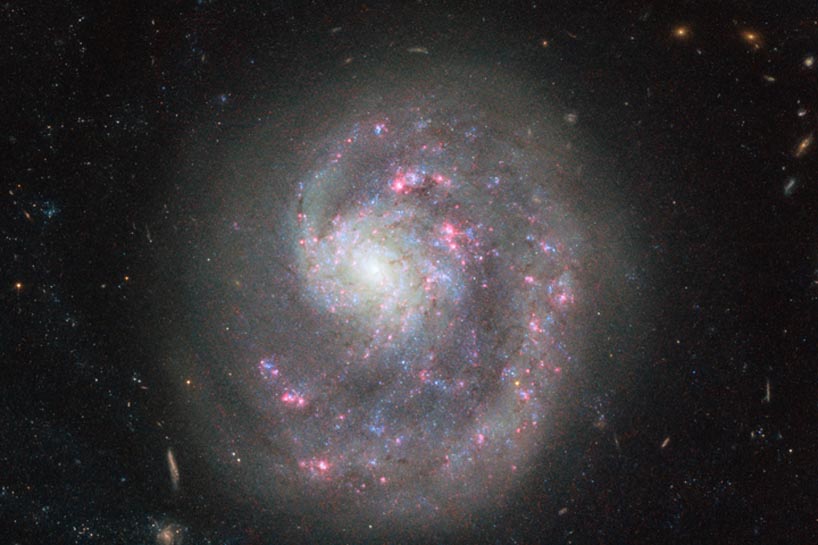
Spiral Galaxy
RA 12h 41m 52.83s Dec 41° 16' 25.90"
Canes Venatici
13.2
1.25 by 1.2 arcmin
30 million light years
2.82 x 1.50 arcminutes
North is 22.5° left of vertical
ESA/Hubble & NASA
November 13, 2017
NGC 4618
ABOUT THIS IMAGE:
This new picture, taken by the NASA/ESA Hubble Space Telescope, shows the dwarf galaxy NGC 4625, located about 30 million light-years away in the constellation of Canes Venatici (The Hunting Dogs). The image, acquired with the Advanced Camera for Surveys (ACS), reveals the single spiral arm of the galaxy, which gives it an asymmetric appearance. But why is there only one spiral arm, when spiral galaxies normally have at least two?
Astronomers looked at NGC 4625 in different wavelengths in the hope of solving this cosmic mystery. Observations in the ultraviolet provided the first hint: in ultraviolet light the disc of the galaxy appears four times larger than on the image depicted here. An indication that there are a large number of very young and hot — hence mainly visible in the ultraviolet — stars forming in the outer regions of the galaxy. These young stars are only around one billion years old, about 10 times younger than the stars seen in the optical centre. At first astronomers assumed that this high star formation rate was being triggered by the interaction with another, nearby dwarf galaxy called NGC 4618.They speculated that NGC 4618 may be the culprit “harassing” NGC 4625, causing it to lose all but one spiral arm. In 2004 astronomers found proof for this claim: The gas in the outermost regions of the dwarf galaxy NGC 4618 has been strongly affected by NGC 4625.
NGC 4625 was discovered on April 9, 1787 by William Herschel
From Wikipedia:
NGC 4625 is a distorted dwarf galaxy in the constellation Canes Venatici. The galaxy is formally classified as a Sm galaxy, which means that its structure vaguely resembles the structure of spiral galaxies. The galaxy is sometimes referred to as a Magellanic spiral because of its resemblance to the Magellanic clouds.
Unlike most spiral galaxies, NGC 4625 has a single spiral arm, which gives the galaxy an asymmetric appearance. It has been hypothesized that this galaxy's asymmetric structure may be the result of a gravitational interaction with NGC 4618. Such asymmetric structure is commonly seen among many interacting galaxies. However, observations of neutral hydrogen gas in NGC 4618 and NGC 4625 show that NGC 4625 does not appear to have been affected by the gravitational interaction. This indicates that the single-arm structure seen in NGC 4625 may be created through intrinsic processes.
Ultraviolet observations of NGC 4625 made by the Galaxy Evolution Explorer (GALEX) show the presence of an extended disk. The new spiral disk extrends 28,000 light-years from the galaxy center, a staggering four times the optical radius. The hot blue stars in this new disk may have formed from the inflow of fresh gas and dust from interaction with its companions, NGC 4618 and NGC 4625A. The UV-to-optical colors suggest that the bulk of the stars in the disk of NGC 4625 are currently being formed, providing a unique opportunity to study today the physics of star formation under conditions similar to those when the normal disks of spiral galaxies like the Milky Way first formed.